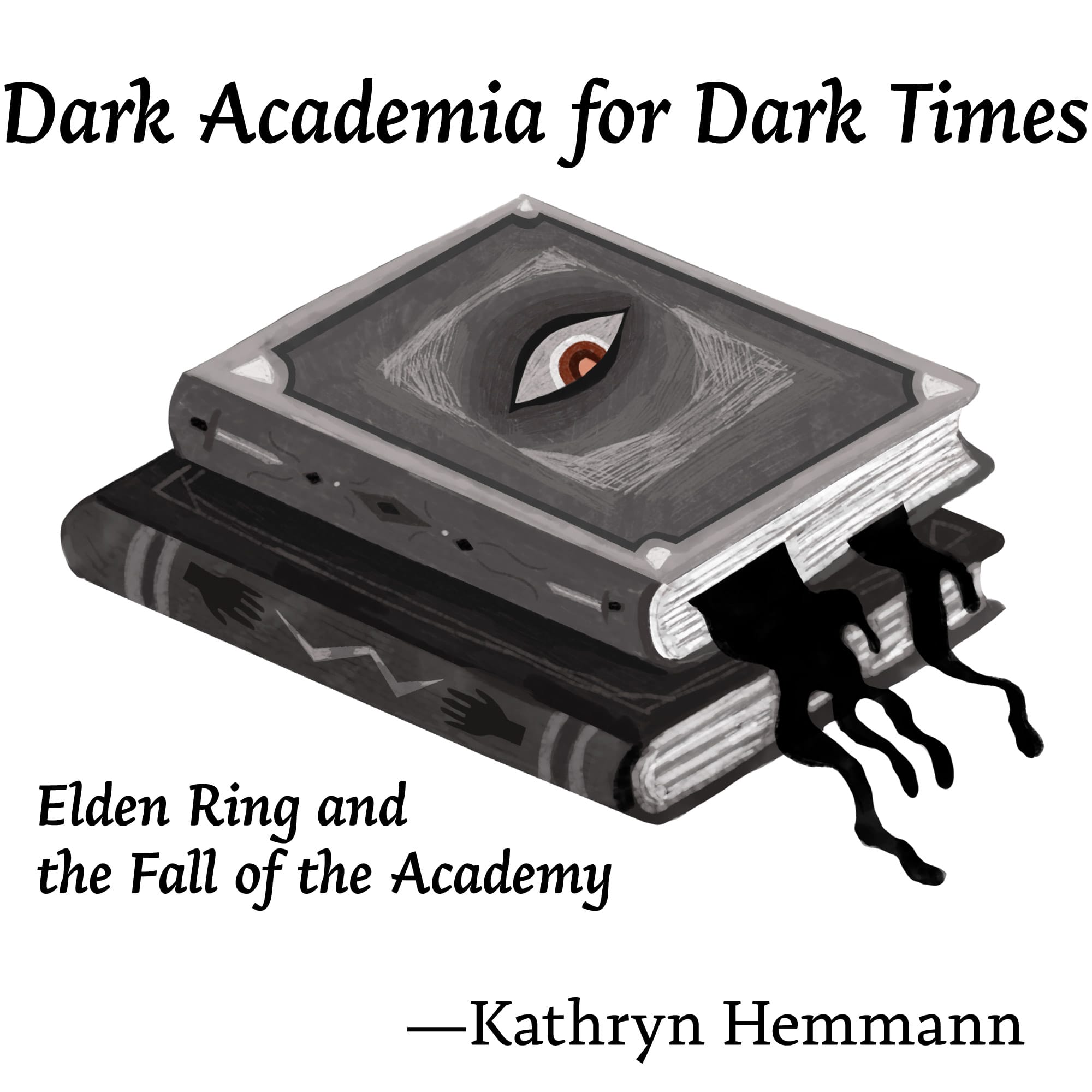Dark Academia for Dark Times: Elden Ring and the Fall of the Academy

For better or worse, an entire generation grew up with the Harry Potter novels. Even as the author of the series has descended into a mire of hateful ideologies, pleasant memories of Hogwarts remain. While many Millennials were trapped in secondary education systems whose emphasis on high test scores demanded onerous workloads, Hogwarts provided an escape to a magical school in a handsome Gothic castle where studying actually conferred useful skills.
Fast forward to the release of Elden Ring in February 2022, which came almost two years into pandemic lockdowns and social distancing. Like its predecessors in FromSoftware’s Dark Souls series, Elden Ring is notoriously difficult. You play as an unnamed warrior who wakes in a crypt under the postapocalyptic Lands Between, where the hostile undead shamble across a blasted landscape that can no longer sustain human civilization. The player’s first task is to navigate the ruins of a fortified castle with no guidance, no allies, and no real understanding of how this place met its terrible fate.
A majestic vista greets players who persevere and manage to make it to the other side of the castle. Towering above the mists of a crystal-encrusted swamp forest is the awe-inspiring architecture of the Academy of Raya Lucaria, a university for the study of cosmic magic administered by the royal family of a region that fell under the sway of a hegemonic imperial power.
Unlike Hogwarts, no charmingly quirky professors appear to greet the player, and there are no lavish banquets under enchanted ceilings. Something is terribly wrong here. Your character’s footsteps echo down empty corridors littered with stacks of rotting books. Most of the remaining scholars are mindless undead, and those that aren’t are actively trying to kill you. Deep in the library, the academy’s headmistress floats gently in the air, driven out of her mind by grief and delusion. The experiments that were once her students crawl at her feet, mewling like infants as they grasp at your ankles.
The Academy of Raya Lucaria is a striking manifestation of the dark academia aesthetic. Marie O’Regan and Paul Kane, the editors of the 2024 horror anthology In These Hallowed Halls, describe dark academia as a concern with “higher education, the arts, and literature, with a focus on the pursuit of knowledge and an exploration of death.” In its more literary forms, dark academia is often Lovecraftian, with the dogged hunt for forbidden knowledge leading to madness, death, or the loss of one’s very soul.
The postapocalyptic setting of Elden Ring frustrates the search for lore, but an observant player can still manage to gather scattered records of the past. A once proud empire has been decimated by a war between a family of demigods infected by the influence of cosmic forces, leaving the landscape shattered and in ruins. The Academy of Raya Lucaria is not immune to the greater conflict, but the majority of its scholars have abstained from battle and sealed the entrances of the academy to protect it from outside invasion. Although safe from the ravages of war, the Academy’s scholars nevertheless brought doom upon themselves through isolation and infighting.
The scholarly specialists in various conspectuses of magic at the Academy study celestial bodies, from the stars to the moon to the “primeval cosmic current” of gravity. Their sorcery is powerful, yet they squander their intellectual acumen on squabbles over purely academic matters. In its fascistic pursuit of academic rigor, the Academy has ostracized many of its students, banishing them to lurk in the dank caves and decaying churches outside its walls. Other students are not so lucky. The Academy contains multitudes of hidden rooms where these unfortunate students will remain forever, quietly screaming in the glow of eternally burning candles.
In keeping with its theme of great cosmic mystery, the physical space of the Academy is modeled on Christian religious architecture, just as the buildings of early European universities were in real life. The Academy’s front vestibule is reminiscent of the nave of a grand cathedral, and the midpoint boss fight rages across a room resembling the choir of a medieval monastery. To navigate the latter half of the stage, the player must leap across flying buttresses and enter the upper level of a building through its shattered clerestory windows. Complementing the handsome granite and marble of the architecture, books and astrolabes and carefully arranged displays of shining gemstones ornament the corridors. Every aspect of the Academy’s visual design creates an environment that reflects the solemnity of the pursuit of scholarship.
As an aesthetic, dark academia exhibits a fascination with monumental architecture. The stone buildings and Gothic spires of numerous tagged photos on social media evoke elite institutions of higher education, which aggressively market their campus architecture in promotional materials. Fashion and culture writer Amal Abdi has described dark academia as “a dreamy digital substitute” for in-person university classes that appealed to many people during the pandemic, and there is indeed a fantastic quality to the grand stone buildings and richly appointed library reading rooms. The interiors of Northumberland’s Alnwick Castle were a key element of the appeal of Hogwarts, after all. This monumental architecture lends a solemn weight to academic endeavors, helping students to feel that their labors—tedious though they may be in the moment—carry a sense of meaning and import that will persist through the years.
In reality, however, many universities have suffered financially since the pandemic. In my home city of Philadelphia, the University of the Arts abruptly announced closure at the end of the Spring 2024 semester, and the historic University of the Sciences may not be far behind, even after having been bought by Saint Joseph’s University in 2021. With steadily declining enrollments and rising attrition rates, even the local STEM field juggernaut Drexel University has severely culled its faculty after severe budget deficits. In a widely shared 2023 article on The Atlantic, “What Happens When a Poor State Guts Its Public University,” Michael Powell documents a broader trend of universities closing programs not deemed as profitable in the long term, even despite active and cogent protests against the closures.
The current financial crisis in higher education is not limited to the United States. With steeply rising tuitions and stricter limitations on visas, Canadian universities saw a 45% decrease in international students in 2024, and the disappearance of the tuition that these students could have provided has become a critical threat for schools that can no longer rely on dwindling provincial aid. Even with a steady influx of students, universities in the United Kingdom are cutting staff and raising tuition as stopgap measures to combat the financial insecurity of decreased government funding.
Meanwhile, shifting demographics toward lower birth rates in Northern Europe and East Asia have put financial pressure on small colleges and large universities alike. In Japan, for instance, the majority of higher education institutions failed to meet student enrollment quotas in 2024, and government advisory bodies have warned that this trend may lead to many university closures in the near future.
Clearly, all is not well in academia. Donna Tartt’s 1992 suspense novel The Secret History, often cited as the ur-text of dark academia, has prophetically become a reflection of the grim reality of higher education. As tuition rises and the funding necessary to support students declines, many colleges have become playgrounds for the idle adult children of the wealthy. Meanwhile, university faculties are divided between the tenured elite and exploited adjuncts, many of whom happily accept the inequalities of their situation with a type of cult mentality. After all, why bother with such mundane affairs as salaries and student debt when your attention could be engaged with loftier matters? And if undeserving students fall through the cracks and disappear forever into a poorly lit library sub-basement, their failure only enhances the prestige of those who succeed.
When I first set foot in the Academy of Raya Lucaria, I was impressed by the grandeur of the architecture and the spectacle of the battles that unfolded in the lecture halls, but I was also unnerved by the echoes of my own experience in higher education. As political unrest and environmental catastrophes beset the world outside the university, tenured scholars bicker over trivial matters and gatekeep incoming hopefuls with practical and culturally relevant research agendas. In the Academy of Raya Lucaria, as in the real world, internal politics have resulted in a certain solipsism in the intellectual output of tenured scholars.
This academic enervation is nowhere more apparent than in the figure of Rennala, the headmistress of the Academy of Raya Lucaria. Rennala married an imperial conqueror who gave her several children before returning to the capital to remarry. Although an accomplished sorcerer and scholar, Rennala was broken by her consort’s betrayal. During the wars that raged across the Lands Between, she ensconced herself within her library, where she now uses her considerable powers to transform those seeking knowledge into insapient infants trapped in adult bodies. She accepts no new students, only replicating mindless copies. Rennala thereby responded to hostile political currents by regressing into the essentialism of a feminine gender role and becoming an eternally fertile mother.
The Academy of Raya Lucaria exemplifies the gendered element of dark academia. The institutions of higher learning that once promised queer and female liberation have collapsed in on themselves as they strive toward the neoliberal ideal of “productivity.” In dark academia, the harm visited on the bodies of women in other genres of horror is transformed into harm forced onto their minds. As universities use financial constraints as an excuse to winnow out the marginalized, even self-evident academic ideologies like feminism can become twisted. We can witness this process, tragically enough, in Hogwarts as well.
As Anna Bogutskaya argues in Feeding the Monster: Why Horror Has a Hold on Us, the purpose of horror is to reflect our fears, while the pleasure of horror lies in the catharsis of seeing the unpleasant truth revealed for what it is. It must be said, however, that there’s also a certain joyful pleasure in witnessing the destruction of a malignant status quo.
The Academy of Raya Lucaria may be a hostile learning environment, but the player’s character is free to overturn bookshelves and murder professors to their heart’s content. In the same bloody vein, contemporary dark academia is an essentially queer genre that delights in following women and femmes of all genders as they exploit and despoil the historically male-dominated institution of higher education with crimes of passion and the pursuit of forbidden knowledge. Even as dark academia reflects the challenges facing contemporary universities, the genre is also a means of reconfiguring universities into an aesthetic stage for enacting fantasies that gleefully subvert the arrogant grandiosity of academia.
While a traditional university education is still largely the domain of the wealthy, anyone on social media can bypass intellectual snobbery and claim the allure of institutional prestige for herself, all the while reading and writing as she pleases. And, once you’ve concealed your murder weapon between the pages of an ancient library book, there’s nothing to stop you from learning to summon a chthonic deity of your own choosing. Undead elder gods don’t care whether you pay off your student loans, and who knows? The monsters we summon through our dark academia fantasies might just provide the motivation we need to bypass scholarly gatekeepers and take control of our own education.
Kathryn Hemmann is the author of numerous articles and essays on Japanese fiction, graphic novels, and video games. Their book Manga Cultures and the Female Gaze was published by Palgrave in 2020, and their current work focuses on queer posthumanism and ecological themes in video games. They teach at the University of Pennsylvania.
X: @kathrynthehuman
Bluesky: @digitalfantasydiary
